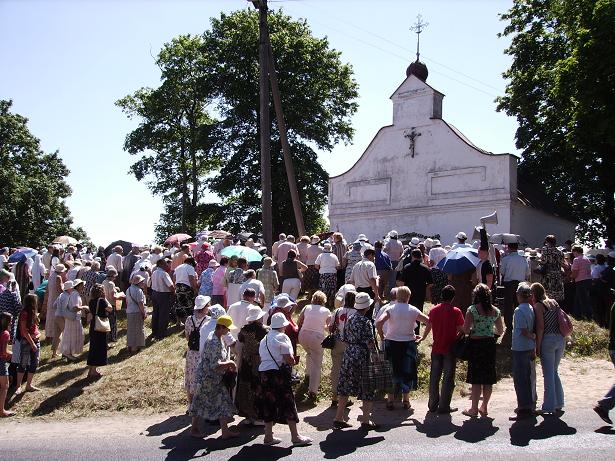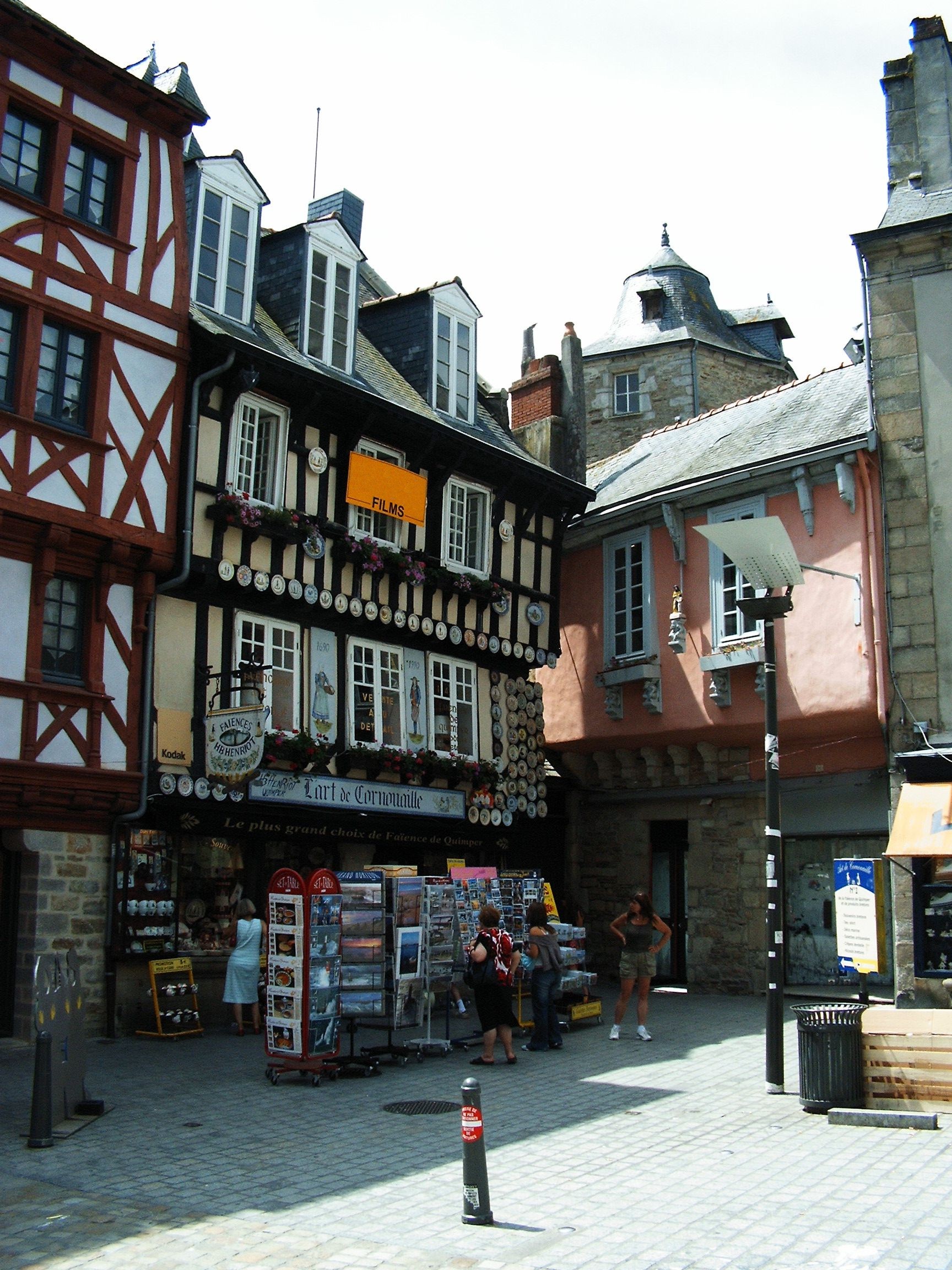|
Kergoat Chapel
The Chapelle Notre-Dame de Kergoat is a 16th century chapel in the hamlet Kergoat, in the commune Quéménéven, Finistère, northwestern France. It has various stained glass windows and contains statues of Sainte Marguerite, Sainte Barbe, Saint Joseph, Saint Francis, Saint Mathurin, John the Baptist with the Virgin Mary. Some other statues have been moved to the musée de Quimper. i.e.Saint Sébastien, Saint Roch, Sainte Marie Madeleine, Sainte Barbe, the Virgin Mary and an "Ecce Homo". The Calvary of the Kergoat chapel is 6.50 metres in height. It includes a table to accommodate offerings. Statues include those of John the Baptist, Saint Guénolé, and John the Evangelist, and a Vierge de Pitié. The chapel and the calvary are a listed historical monument since 1935. Chapelle Notre-Dame de Kergoat The pardon de Kergoat The Kergoat pardon was immortalised by the painter Jules Breton in 1891 with the painting ''Le Pardon de Kergoat''. This painting is held in the Quimper Quimp ... [...More Info...] [...Related Items...] OR: [Wikipedia] [Google] [Baidu] |
Chapel
A chapel is a Christian place of prayer and worship that is usually relatively small. The term has several meanings. Firstly, smaller spaces inside a church that have their own altar are often called chapels; the Lady chapel is a common type of these. Secondly, a chapel is a place of worship, sometimes non-denominational, that is part of a building or complex with some other main purpose, such as a school, college, hospital, palace or large aristocratic house, castle, barracks, prison, funeral home, cemetery, airport, or a military or commercial ship. Thirdly, chapels are small places of worship, built as satellite sites by a church or monastery, for example in remote areas; these are often called a chapel of ease. A feature of all these types is that often no clergy were permanently resident or specifically attached to the chapel. Finally, for historical reasons, ''chapel'' is also often the term used by independent or nonconformist denominations for their places of wor ... [...More Info...] [...Related Items...] OR: [Wikipedia] [Google] [Baidu] |
Quéménéven
Quéménéven (; br, Kemeneven) is a commune in the Finistère department of Brittany in northwestern France. Notable monuments include the Quéménéven Parish close in the village centre, and the Kergoat chapel in the hamlet Kergoat. Population Inhabitants of Quéménéven are called in French ''Quéménévenois''. See also *Communes of the Finistère department The following is a list of the 277 communes of the Finistère department of France. The communes cooperate in the following intercommunalities (as of 2022):Official website * Mayors of Finistère Association ... [...More Info...] [...Related Items...] OR: [Wikipedia] [Google] [Baidu] |
Finistère
Finistère (, ; br, Penn-ar-Bed ) is a department of France in the extreme west of Brittany. In 2019, it had a population of 915,090.Populations légales 2019: 29 Finistère INSEE History |
France
France (), officially the French Republic ( ), is a country primarily located in Western Europe. It also comprises of Overseas France, overseas regions and territories in the Americas and the Atlantic Ocean, Atlantic, Pacific Ocean, Pacific and Indian Oceans. Its Metropolitan France, metropolitan area extends from the Rhine to the Atlantic Ocean and from the Mediterranean Sea to the English Channel and the North Sea; overseas territories include French Guiana in South America, Saint Pierre and Miquelon in the North Atlantic, the French West Indies, and many islands in Oceania and the Indian Ocean. Due to its several coastal territories, France has the largest exclusive economic zone in the world. France borders Belgium, Luxembourg, Germany, Switzerland, Monaco, Italy, Andorra, and Spain in continental Europe, as well as the Kingdom of the Netherlands, Netherlands, Suriname, and Brazil in the Americas via its overseas territories in French Guiana and Saint Martin (island), ... [...More Info...] [...Related Items...] OR: [Wikipedia] [Google] [Baidu] |
Calvary (sanctuary)
A calvary, also called calvary hill, Sacred Mount, or Sacred Mountain, is a type of Christian sacred place, built on the slopes of a hill, composed by a set of chapels, usually laid out in the form of a pilgrims' way. It is intended to represent the passion of Jesus Christ and takes its name after Calvary, the hill in Jerusalem where, according to tradition, Jesus was crucified. These function as greatly expanded versions of the Stations of the Cross that are usual in Catholic churches, allowing the devout to follow the progress of the stages of the Passion of Christ along the Via Dolorosa in Jerusalem. Each chapel contains a large image of the scene from the Passion it commemorates, sometimes in sculpture, that may be up to life-size. This kind of shrine was especially popular in the Baroque period when the Holy Land was under Turkish rule and it was difficult to make a pilgrimage to the Mount Calvary in Jerusalem. Calvaries were especially popular with the Franciscan ... [...More Info...] [...Related Items...] OR: [Wikipedia] [Google] [Baidu] |
Monument Historique
''Monument historique'' () is a designation given to some national heritage sites in France. It may also refer to the state procedure in France by which National Heritage protection is extended to a building, a specific part of a building, a collection of buildings, a garden, a bridge, or other structure, because of their importance to France's architectural and historical cultural heritage. Both public and privately owned structures may be listed in this way, as well as movable objects. As of 2012 there were 44,236 monuments listed. The term "classification" is reserved for designation performed by the French Ministry of Culture for a monument of national-level significance. Monuments of lesser significance may be "inscribed" by various regional entities. Buildings may be given the classification (or inscription) for either their exteriors or interiors. A monument's designation could be for a building's décor, its furniture, a single room, or even a staircase. An example is ... [...More Info...] [...Related Items...] OR: [Wikipedia] [Google] [Baidu] |
Jules Breton
Jules Adolphe Aimé Louis Breton (1 May 1827 – 5 July 1906) was a 19th-century French naturalist painter. His paintings are heavily influenced by the French countryside and his absorption of traditional methods of painting helped make Jules Breton one of the primary transmitters of the beauty and idyllic vision of rural existence. Early life and training Breton was born on 1 May 1827 in Courrières, a small Pas-de-Calais village. His father, Marie-Louis Breton, supervised land for a wealthy landowner. His mother died when Jules was 4 and he was brought up by his father. Other family members who lived in the same house were his maternal grandmother, his younger brother, Émile, and his uncle Boniface Breton. A respect for tradition, a love of the land and for his native region remained central to his art throughout his life and provided the artist with many scenes for his Salon compositions. His first artistic training was not far from Courrières at the College St. B ... [...More Info...] [...Related Items...] OR: [Wikipedia] [Google] [Baidu] |
Quimper
Quimper (, ; br, Kemper ; la, Civitas Aquilonia or ) is a commune and prefecture of the Finistère department of Brittany in northwestern France. Administration Quimper is the prefecture (capital) of the Finistère department. Geography The city was built on the confluence of the Steir, Odet and Jet rivers. Route National 165, D785, D765 and D783 were constructed to intersect here, northwest of Lorient, west of Rennes, and west-southwest of Paris. Climate Quimper has a oceanic climate (Köppen climate classification ''Cfb''). The average annual temperature in Quimper is . The average annual rainfall is with December as the wettest month. The temperatures are highest on average in August, at around , and lowest in February, at around . The highest temperature ever recorded in Quimper was on 30 June 1976; the coldest temperature ever recorded was on 13 January 1987. Etymology The name ''Quimper'' comes from the Breton ''kemper'', meaning "confluent". History Qui ... [...More Info...] [...Related Items...] OR: [Wikipedia] [Google] [Baidu] |
Churches In Finistère
Church may refer to: Religion * Church (building), a building for Christian religious activities * Church (congregation), a local congregation of a Christian denomination * Church service, a formalized period of Christian communal worship * Christian denomination, a Christian organization with distinct doctrine and practice * Christian Church, either the collective body of all Christian believers, or early Christianity Places United Kingdom * Church (Liverpool ward), a Liverpool City Council ward * Church (Reading ward), a Reading Borough Council ward * Church (Sefton ward), a Metropolitan Borough of Sefton ward * Church, Lancashire, England United States * Church, Iowa, an unincorporated community * Church Lake, a lake in Minnesota Arts, entertainment, and media * '' Church magazine'', a pastoral theology magazine published by the National Pastoral Life Center Fictional entities * Church (''Red vs. Blue''), a fictional character in the video web series ''Red vs. Blue'' * Chur ... [...More Info...] [...Related Items...] OR: [Wikipedia] [Google] [Baidu] |



